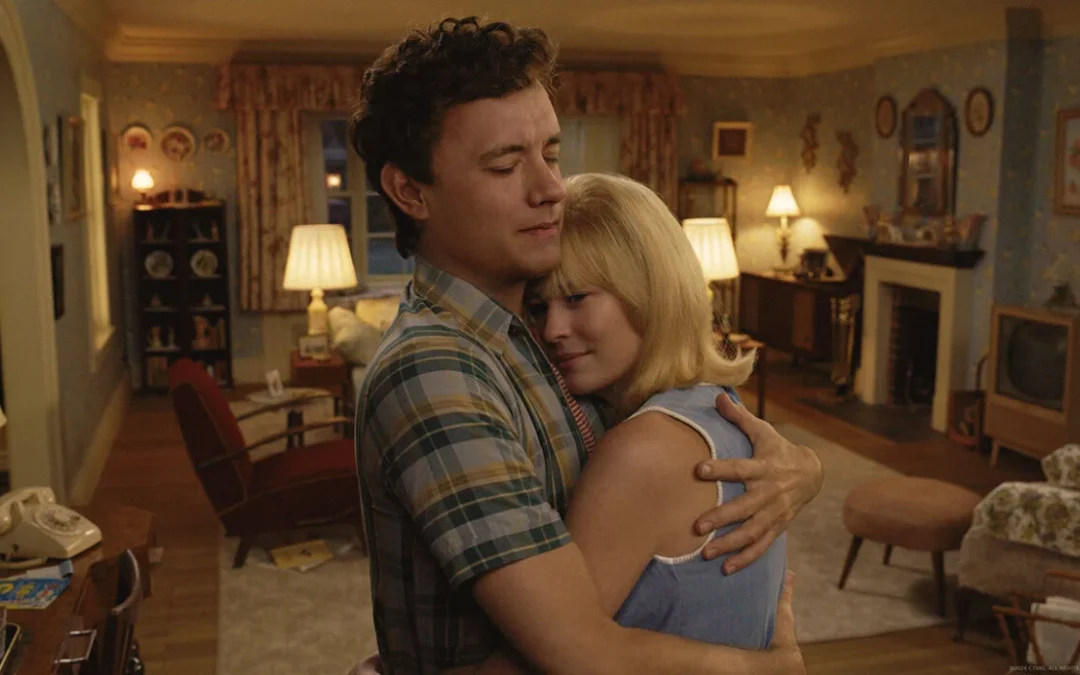Here (2 1/2 Stars out of 4)
30 years ago, Robert Zemeckis directed Tom Hanks and Robin Wright in “Forrest Gump,” a heartfelt journey through the 2nd half of the 20th century told through the eyes of an eccentric simpleton. “Gump” won Best Picture and Best Actor for Hanks.
Three decades later, Zemeckis is returning to the well in a sense. Not with a sequel to “Gump,” but with an adaptation of a graphic novel that covers a lot of the same ground. “Here” is the story of a place, specifically, a living room in New England. Through creative transitions that evoke its source material, Zemeckis jumps back and forth in time, showing us different residents, owners, and events throughout history.
Though we occasionally see more broad illustrations of the location’s history, through pre-historic flashes of dinosaurs or pre-colonial use by Native Americans, most of “Here” takes place after the construction of a home on the site in 1900. The non-sequential plot includes five primary owners, and mainly focuses on two: a WWII veteran-turned vacuum salesman named Al (Paul Bettany), and his oldest son Richard, played by Hanks.
Al’s family occupies the home from the mid-1940s to the early 21st century. We see Al and his new bride Rose (Kelly Reilly) balk at the steep asking price of $3,400, then cave in and go about building a family. We see a teenage Richard bring home his new girlfriend Margaret (Wright), who quickly becomes Richard’s wife after she gets pregnant. Richard and Margaret stay at the family home in fear of high mortgage rates, and Richard sets aside his ambitious in the graphic arts to take on a more serviceable career.
From time to time we get interludes of the other families who came before and after…an early 20th century flying enthusiast and his terrified wife, an ambitious inventor who seems destined for greater things, and a young African-American family who represent the present day. But most of our time is spent with Richard and Margaret as they navigate the turbulent 1960s and 70s, hoping for better circumstances, but always deferring to caution as they have to care for Richard’s now aging parents.
The furniture, decorations, and different televisions that occupy the room give Zemeckis opportunity to use flashes of familiar sights and sounds to color in the popular culture of the time, even going so far as to depict historical events on television broadcasts. It’s a little more indirect than Forrest Gump’s chaotic stumble through history, but it mines the same sense of nostalgia.
One of the more impressive elements of the film is the de-aging effects used to portray Hanks and Wright. We never quite buy them as teenagers, but compared to a lot of recent efforts, their 20 and 30-something selves aren’t near as distracting or noticeable.
At the same time, “Here” tends to focus on the more tragic events as it paints a cross-section of life’s journey. Perhaps its due to the source material, but in a lifetime full of the bittersweet, “Here” seems more interested in the former than the latter, and a little more depiction of life’s joys might leave viewers with a more satisfactory experience.
For their parts, Hanks and Wright—not to mention Bettany—give reliable performances, though no one gets too much opportunity to shine. Ultimately, “Here” sacrifices some of its impact by making the place the protagonist, and denying us a fuller exploration of its human inhabitants. Zemeckis’s film deserves to be noted for its creativity—and may be remembered for its heartfelt Forrest Gump reunion—but it won’t be celebrated as a strong film.
“Here” is rated PG-13 for profanity and some implied sexual content.

